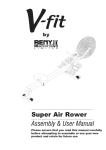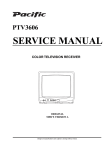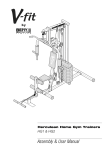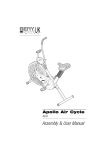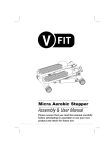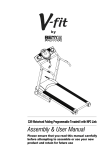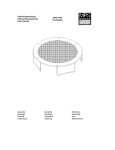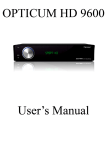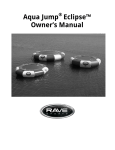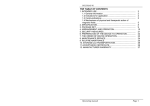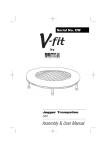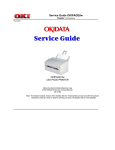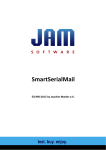Download Assembly
Transcript
12' / 14' Family Trampoline GE030 / 31 Assembly & User Manual Contents Section Page General Information . . . . . . 4 Before you start . . . . . . . . . 5 Safety . . . . . . . . . . . . . . . . . 6 Exercise Information . . . . . . 9 Assembly . . . . . . . . . . . . . . 17 General Information Quality Guarantee This V-fit product has been designed and manufactured to comply with the latest (BS EN 13219) British and European Safety Standards. Beny Sports Co. UK Ltd. guarantee's its V-fit product range for DOMESTIC USE only for a period of 2 years from certified date of purchase. During this period we have the right to: a). provide parts for the purchaser to effect repair. Questions Should you encounter any difficulty with the assembly, operation or use of your V-fit exercise product or if you think that you may have parts missing, please DO NOT return it to your retailer but contact us first for help and advice, asking for CUSTOMER SUPPORT, by any of the following means. c). replace the product if it is deemed economical to do so. This guarantee applies to the original purchaser only and is not transferable. This guarantee does not cover wear and tear on upholstery or consumables. Tel:- 0871 222 0881 or Fax:- 01535 637722 or Email:- [email protected] CUSTOMER SUPPORT is open from 9.00am to 5.00pm from Monday to Friday Beny Sports Co. UK Ltd. Unit 8, Riparian Way, The Crossings, Cross Hills, West Yorkshire. BD20 7BW This guarantee does not cover abuse or defects caused by storage or use outside those intended. If you need to advise us of a defect with your product, we may ask for proof of purchase. To enable us to service your requirement for replacement parts, you must return the enclosed Guarantee Registration Card within 14 days of purchase. Failure to do so may result in any claim for replacement parts or repairs being refused. This does not affect your statutory rights as a consumer. Queries If you do have any queries, please ensure that you have the following information ready for our Customer Support Staff: YOUR NAME YOUR ADDRESS YOUR PHONE NUMBER PRODUCT MAKE OR BRAND PRODUCT MODEL PRODUCT SERIAL NUMBER DATE OF PURCHASE NAME OF RETAILER PART NUMBERS REQUIRED Page 4 b). repair the product returned (at the purchaser's cost) to our warehouse. Customer Support Tel:- 0871 222 0881 or Fax:- 01535 637722 or Email:- [email protected] CUSTOMER SUPPORT is open from 9.00am to 5.00pm from Monday to Friday Beny Sports Co. UK Ltd. Unit 8, Riparian Way, The Crossings, Cross Hills, West Yorkshire. BD20 7BW Family Trampoline Before you Start Tools If reguired, all of our products are supplied with basic tools, which will enable you to successfully assemble your product. However, you may find it beneficial to have a soft-headed hammer and perhaps an adjustable spanner handy as this may help. Prepare the Work Area It is important that you assemble your product in a clean, clear, uncluttered area. This will enable you to move around the product while you are fitting components and will reduce the possibility of injury during assembly. Work with a Friend You may find it quicker, safer and easier to assemble this product with the help of a friend as some of the components may be large, heavy or awkward to handle alone. Open the Carton. Carefully open the carton that contains your product, taking note of the warnings printed on the carton to ensure that the risk of injury is reduced. Be aware of sharp staples that may be used to fasten the flaps as these may cause injury. Be sure to open the carton the right way up, as this will be the easiest and safest way to remove all the components. Unpack the Components Carefully unpack each component, checking against the parts list that you have all the necessary parts to complete the assembly of your product. Please note that some of the parts may be pre-fitted to major components, so please check carefully before contacting our CUSTOMER SUPPORT team. In any event, please do not return the product to your retailer before contacting us first. Family Trampoline Page 5 Safety-General Please read this manual carefully before commencing assembly of your trampoline or starting to use it. * For your own safety, always ensure that there is at least 1 Metre of free space in all directions around your product while using your trampoline. * Regularly check to see that all nuts, bolts and fittings are securely tightened. Periodically checking all moving parts for obvious signs of wear or damage. * Clean only with a damp cloth, do not use solvent cleaners. If you are in any doubt, do not use your V-fit product, but contact CUSTOMER SUPPORT by any of the means listed on the opposite page. * Before use, always ensure that your V-fit product is positioned on a solid, flat surface. * Always wear appropriate clothing and footwear when exercising. Do not wear loose clothing that could become caught or trapped during exercise. Storage and Use Your V-fit product is intended for use in clean dry conditions. You should avoid storage in excessively cold or damp places if possible as this may lead to corrosion and other related problems that are outside our control. Weight Limit Your V-fit product is suitable for users weighing: 220LBS / 15.7 Stones / 100KG or less. Conformity This V-fit product conforms to: (BS EN 13219) - Class (H) - HOME USE - Class (C). It is NOT suitable for therapeutic purposes. Liability Beny Sports Co. UK Ltd. Its agents or employees can not be held responsible for any damage or injury occurred or sustained by the users or owners of this trampoline. Use and storage of this trampoline is entirely the responsibility of the users and owners. Page 6 Family Trampoline Safety-Trampoline Specific INTRODUCTION Before you begin use of this trampoline, be sure to carefully read all the information provided to you in this manual. Just like any other type of physical recreational activity, participants can be injured. To reduce the risk of injury, be sure to follow appropriate safety rules and tips. Ø Ø Ø Ø Misuse and abuse of this trampoline is dangerous and can cause serious injury! Trampolines, being rebounding devices, propel the performer to unaccustomed heights and into a variety of body movements. Always inspect the trampoline before each use for worn-out mat, loose or missing parts. Proper assembly, care and maintenance of product, safety tips, warnings, and proper techniques in jumping and bouncing are all included in this manual. All users and supervisors must read and familiarize themselves with these instructions. Anybody who chooses to use this trampoline must be aware of their own limitations in regards to performing various jumps and bounces with this trampoline. warning NO MORE THAN ONE PERSON AT A TIME ON THE TRAMPOLINE! MULTIPLE JUMPERS INCRASE THE RISK OF INJURY SUCH BROKEN HEAD, NECK, LEG, OR BACK PARALYSIS OR DEATH CAN RESULT IF YOU LAND ON YOUR HEAD OR NECK! DO NOT PERFORM SOMERSUALTS (FLIPS) AS THIS WILL INCREASE YOUR CHANCES OF LANDING ON YOUR HEAD OR NECK! ALWAYS CONSULT A DOCTOR BEFORE PERFORMING ANY KIND OF PHYSICAL ACTIVITY Ø Ø Ø Ø Ø Ø Ø Ø Ø Adequate overhead clearance is essential. A minimum of 24 ft from ground level is recommended. Provide clearance for wires, tree limbs, and other possible hazards. Lateral clearance is essential. Place the trampoline away from walls, structures, fences, and other play areas. Maintain a clear space on all sides of the trampoline. Place the trampoline on a level surface before use, illumination may be required for shady areas. Secure the trampoline against unauthorized and unsupervised use. Remove any obstructions from beneath the trampoline. The owner and supervisors of the trampoline are responsible to make all users aware of practices specified in the use instructions. Do not attempt or allow somersaults. Landing on the head or neck can cause serious injury, paralysis or death, even when landing in the middle of the bed. Do not allow more than one person on the trampoline. Use by more than one person at the same time can result in serious injury. Use trampoline only with mature, knowledgeable supervision. Family Trampoline Page 7 Safety-Trampoline Specific (continued) WARNING Ø Ø Ø Ø Ø Ø Ø Ø Ø Trampolines over 20in (51 cm) tall are not recommended for use by children under 6 years of age. Inspect the trampoline before each use. Make sure the frame padding is correctly and securely positioned. Replace any worn, defective, or missing parts. Climb on and off the trampoline, it is a dangerous practice to jump from the trampoline to the floor or ground when dismounting, or to jump onto the trampoline when mounting. Do not use the trampoline as a springboard to other objects. Stop bounce by flexing knees as feet come in contact with the trampoline bed. Learn this skill before attempting others. Learn fundamental bounces and body positions thoroughly before trying more advanced skills. A variety of trampoline activities can be carried out by performing the basic fundamentals in various series and combinations, performing and fundamental after another, with or without feet bounces between them. Avoid bouncing too high. Stay low until bounce control and repeated landing in the center of the trampoline can be accomplished. Control is more important than height. Focus eyes on the trampoline. This will help control bounce. Avoid bouncing when tired. Keep turns short. Properly secure the trampoline when not in use. Protect it against unauthorized use. If a trampoline ladder is used, the supervisor should remove it from the trampoline when leaving the area to prevent unsupervised access by children under 6 years of age. Ø Ø Trampolines are not for children under 6 years of age. Supervise the activities of all children who use this trampoline. Ø Keep objects away which could interfere with the performer. Maintain a clear area around the trampoline. Do not use the trampoline while under the influence of alcohol or drugs. For information concerning skill training, contact a certified trampoline instructor. Ø Ø Ø Ø Ø Bounce only when the surface of the bed is dry. Wind or air movement should be calm to gentle. Do not use the trampoline in wet weather. The trampoline must not be used in gusty or severe winds. Always start your jump at the broken circle printed on the trampoline mat. When you land more than 1ft away from the edge of the broken circle, stop your jump immediately!! Restart your jump at the broken circle. Ø Read all instructions before using the trampoline, warnings and instructions for the care, maintenance, and use of this trampoline are included to promote safe, enjoyable use of this equipment. Page 8 Family Trampoline Safety-Trampoline Specific (continued) WARNING TRAMPOLINE PLACEMENT The minimum overhead clearance required is 24 feet (7.3 meters). In terms of horizontal clearance, please ensure that no hazardous objects are near the trampoline such as tree limbs, other recreational objects (i.e. swing sets, swimming pools), electrical power wiring, walls, fences, etc. For safe use of the trampoline, please be aware of the following when selecting a place for your trampoline: Make sure it is placed on a level surface The area is well – lighted There are no obstructions beneath the trampoline When not in use, the trampoline shall be secured against unauthorized use. Do not place trampoline on concrete floor, hard ground surface (i.e. rock) or slippery surface. Do not use indoors. If you do not follow these guidelines, you increase the risk of someone getting injured. This trampoline was designed and manufactured with quality materials and craftsmanship. If proper care and maintenance is provided, it will provide all jumpers with years of exercise, fun, and enjoyment as well as reduce the risk of injury. Please follow the guidelines listed below: This trampoline is designed to withhold a certain amount of weight and use. Please make sure that only one person at any one time uses the trampoline. Also, the person should weigh less than 220 pounds, jumpers should either wear socks, gymnastics shoes, or be barefoot when using the trampoline. Please be aware that street shoes or tennis shoes should NOT be worn while using the trampoline. In order to prevent the trampoline mat from getting cut or damaged please do not allow any pets onto the mat. Also, jumpers should remove all sharp objects from their person prior to using the trampoline. Any type of sharp or pointed objects should be kept off the trampoline mat at all times. Always inspect the trampoline before each use for worn, abused or missing parts. A number of conditions could arise that may increase your chances of getting injured. Please be aware of: Ø Punctures, holes, or tears in the trampoline mat Ø Sagging trampoline mat Ø Loose stitching or any kind of deterioration of the mat Ø Bent or broken frame parts, such as the legs Ø Broken, missing, or damaged springs Ø Damaged, missing, or insecurely attached frame pad Ø Protrusions of any types (especially sharp type) on the frame, springs ,or mat IF YOUR FIND ANY OF THE PREVIOUS CONDITIONS, OR ANYTHING ELSE THAT YOU FEEL COULD CAUSE HARM TO ANY USER. THE TRAMPOLINE SHOULD BE DISASSEMBLED OR SECURED FROM USE UNTIL THE CONDITION(S) HAS BEEN RESOLVED. WINDY CONDITIONS In severe wind situations, the trampoline can be blown about. If you expect windy weather conditions, the trampoline should be moved to a sheltered area or disassembled. Another option is to tie the round, outside portion (top frame) of the trampoline to the ground using ropes security, at least three (3) tie downs should be used. Do not just secure the legs of the trampoline to the ground because they can pull out the frame and stakes. To ensure security, at least three (3) tie downs should be used. Do not just secure the legs of the trampoline to the ground because they can pull out the frame sockets. TRAMPOLINES OVER 20 IN. (51CM) TALL ARE NOT RECOMMENDED FOR USE BY CHILDREN UNDER 6 YEARS OF AGE. DO NOT USE INDOORS. Family Trampoline Page 9 Exercise Information INFORMATION ON USE OF THE TRAMPOLINE Initially, you should get accustomed to the feel and bounce of the trampoline. The focus must be on the fundamentals of your body position and you should practice each bounce (the basic bounces) until you can do each skill with ease and control. To brake a bounce, all you need to do is flex your knees sharply before they come in contact with the mat of the trampoline. This technique should practiced while you are learning each of the basic bounces. The skill of braking should be used whenever you lose balance or control of your jump. Always learn the simplest bounce first and be consistent with the control of your bounce before moving on to more difficult and advanced bounces. A controlled bounce is one when your take off point and landing point is the same spot on the mat. If you move up to the next bounce without first mastering the previous, you increase your chances of getting injured Do not bounce on the trampoline for extended periods of time because fatigue can increase your chances of becoming injured. Bounce for a brief period of time and then allow others to join in on the fun! Never have more than one person bouncing on the trampoline. Jumpers should wear T-shirt, shorts or sweats, and regulation gymnastics shoes, heavy socks, or be barefoot. If you are just beginning, you may want to wear long sleeve shirts and pants to protect against scrapes and abrasions until you master correct landing positions and form. Do not wear hard sole shoes, such as tennis shoes on the trampoline, as this will cause excessive wear on the mat material. You should always mount and dismount properly in order to avoid injury. To mount properly, you should PLACE your hand on the frame and either step or roll up onto the frame, over the springs, and onto the trampoline mat. You should always remember to place your hands onto the frame while mounting or dismounting. Do not step directly onto the frame pad or grasp the frame pad. To dismount properly, move over to the side of the trampoline and place your hand onto the frame as a support and step from the mat to the ground. Smaller children should be assisted when mounting and dismounting the trampoline. Do not bounce recklessly on the trampoline since this will increase your chances of getting injured. The key to safety and having fun on the trampoline is control and mastering the various bounces. Never try to out-bounce another bouncer in terms of height! Never use the tramp oline alone without supervision. Page 10 Family Trampoline Exercise Information Multiple Jumpers: If you have multiple jumpers (more than on person on the trampoline at any one time), you increase the chance of getting injured. Injuries could occur when you fly off the tram poline, lose control, collide with the other jumper(s), or land on the springs. Generally, the lightest person on the trampoline will get injured. Striking the Frame or Springs: When playing on the trampoline, STAY in the center of the mat. This will reduce your risk of getting injured by landing on the frame or springs. Always keep the frame pad covering the frame of the trampoline. DO NOT jump or step onto the frame pad directly since it was not intended to support the weight of a person. Loss of Control: DO NOT try difficult maneuvers, or any maneuver until you have mastered the previous maneuver, or if you are just learning how to jump on a trampoline. If you do, you will increase your risk of getting injured by landing on the frame, springs, or off the trampoline completely because you might lose control of your jump. A controlled jump is considered landing on the same spot that you took off from. If you do lose control when you are jumping on the trampoline, bend your knees sharply when you land and this will allow you to regain control and stop your jump. Somersaults (Flips): DO NOT PERFORM somersaults of any type (backwards or forwards) on this trampoline, if you make a mistake when trying to perform a somersault, you could land on your head or neck. This will increase your chances of getting your neck or back broken, which will result in death or paralysis. Foreign Objects: DO NOT use the trampoline if there are pet, other people, or any objects underneath the trampoline. This will increase the chances of an injury occurring. DO NOT hold any foreign objects in your hand and DO NOT place any objects on the trampoline while anyone is playing on it. Please be aware of what is overhead when you are playing on the trampoline. Tree limbs, wires, of other objects located over the trampoline will increase your chances of getting injured. Poor Maintenance of Trampoline: A trampoline in poor condition will increase your risk of getting injured. Please inspect the trampoline before each use for bent steel tubes, torn mat, loose or broken springs, and overall stability of the trampoline. Weather Conditions: Please be aware of the weather conditions when using the trampoline. If the mat of the trampoline is wet, the jumper could slip and injure him or herself. If it is too windy, jumpers could lose control. Limiting Access: When the trampoline is not in use, always store any access ladder in a secure place so that unsupervised children cannot play on the trampoline. Family Trampoline Page 11 Exercise Information TIPS TO REDUCE THE RISK OF ACCIDENTS Jumper’s role in accident prevention. The key here is to stay in control of your jumps. DO NOT move onto more complicated, more difficult maneuvers until you have mastered the basic, fundamental bounce. Education is also key to safety and very important. Read, understand, and practice all safety precautions and warnings prior to using the trampoline. A controlled jump is when you land and take off from the same location. For additional safety tips and instructions, contact a certified trampoline instructor. Supervisor’s Role in Accident Prevention. Supervisors need to understand and enforce all safety rules and guidelines. It is the responsibility of the supervisor to provide knowledgeable advice and guidance to all jumpers of the trampoline. If supervision is unavailable or inadequate, the trampoline could be stored in a secure place, disassembled to prevent unauthorized use, or covered with a heavy tarp that can be locked or secured with lock or chains. The supervisor is also responsible to ensure that the safety placard is placed on the trampoline and that jumpers are informed of these warnings and instructions. TRAMPOLINE SAFETY INSTRUCTIONS JUMPERS: Ø Do not use trampoline if you have consumed alcohol or drugs Ø Remove all hard and sharp objects from person before using trampoline Ø You should climb on and off in a controlled and careful manner. Never jump on or off the trampoline and never use the trampoline as a device to bounce onto or into another object. Ø Always learn the basic bounce and master each type of bounce before trying more difficult types of bounces. Review the Basic Skills Section to learn how to do the basics Ø To stop your bounce, flex your knees when you land on the mat with your feet Ø Always be in control when you are bouncing on the trampoline. A controlled jump is when you land at the same spot that you took off from. If at any time you feel out of control, try to stop your bouncing Ø Do not jump or bounce for prolonged periods of time or too high for a number of jumps Ø Keep your eyes in the mat to maintain control. If you do not, you could lose balance or control Ø Never have more than 1 person on the trampoline at any one time Ø Always have a supervisor watching you when you are on the trampoline Page 12 Family Trampoline Exercise Information SUPERVISORS Educate yourself with the basic jumps and safety rules. To prevent and reduce the risk of injuries, enforce all safety rules and ensure that new jumpers learn the basic bounces before trying more difficult and advanced jumps. Ø All jumpers need to be supervised, regardless of skill level or age. Ø Never use the trampoline when it is wet, damaged, dirty, or worn out. The trampoline should be inspected before any jumpers start bouncing on it. Ø Keep all objects that could interfere with the jumper away from the trampoline. Be aware of what is overhead, underneath, and around the trampoline. Ø To prevent unsupervised and unauthorized use, the trampoline should be secured when not in use. LESSON PLAN The following lessons are suggested in order to learn basic steps and bounces before moving onto more difficult, complicated bounces. Before actually getting on and using the trampoline, you should read and understand all safety instructions. A complete discussion and demonstration of body mechanics and trampoline guidelines should occur between the supervisor and student as well.. Lesson 1 A Mounting and Dismounting-Demonstration of proper techniques B The Basic Bounce-Demonstration and practice C Braking (Check the Bounce-Demonstration) and practice. Learn to brake on command D Hands and knees-Demonstration and practice. Stress should be on four-point landing and alignment Lesson 2 A Review and practice of techniques learned in Lesson1 B Knees Bounce-Demonstration and practice. Learn the basic down to knee and back up before trying half twist to left and right C Seat Bounce-Demonstration and practice. Learn basic seat bounce then add a knee bounce, hands and knees; repeat. Lesson 3 A Review and practice skills and techniques learned in previous lessons B Front Drop-To avoid mat burns and teach the front bounce position, all students should be requested to assume the prone position (face down on the ground) while the instructor checks for faulty positions that could cause injury. C Start with a hands and knees bounce and then extend body into prone position, and on the mat and return to feet D Practice Routine-Hands and knees Bounce, Front Bounce, back to feet, seat bounce, back to feet, seat bounce, back to feet Family Trampoline Page 13 Exercise Information Lesson 4 A B Review and practice skills and techniques learned in previous lessons Half-Turn i ii Start from front drop position and as you make contact with mat, push off with arms in either the right or left direction and turn head and shoulders in same direction. During turn, be sure to keep back parallel to mat and head up. iii After completing turn, land in front drop position After completing this lesson, the student now has a basic foundation of trampoline bounces. Jumpers should be encouraged to try and develop their own routines with the emphasis on control and form.. A game that can be played in order to encourage students to try develop routines is “BOUNCE”. In this game, players count off from 1 to X. Player one starts with a maneuver. Player two has to do Player one’s maneuver and add on another. Player cannot do the routine properly in the correct sequence. The first person to miss, receives the letter “B”. This continues until someone spells out the word “BOUNCE”. The last remaining contestant is deemed the winner! Even when playing this game, it is important to perform your routines under control and not try difficult or highly skilled bounces that you have not yet mastered. A certified trampoline instructor should be contacted to further develop your trampoline skills. BASIC TRAMPOLINE BOUNCES THE BASIC BOUNCE 1. Start from standing position, feet shoulder width apart and with head up and eyes on mat. 2. Swing arms forward and up and around in a circular motion. 3. Bring feet together while in mid-air and point toes downward. 4. Keep feet shoulder width apart when landing on mat. KNEE BOUNCE 1. Start with basic bounce and keep it low. 2. Land on knees keeping back straight, body erect and use your arms to maintain balance. 3. Bounce back to basic bounce position by swinging arms up. Page 14 Family Trampoline Exercise Information SEAT BOUNCE 1. Land in a flat sitting position. 2. Place hands on mat besides hips, do not lock your elbow. 3. Return to erect position by pushing with hands. FRONT BOUNCE 1. Start with a low bounce. 2. Land in prone (face down) position and keep hand and arms extended forward on mat. 3. Push off the mat with arms to return to standing position. 180 DEGREE BOUNCE 1. Start with front bounce position. 2. Push off with left or right hands and .. on which way you arms (depending wish to turn). 3. Maintain head and shoulders in the same direction and keep back parallel to mat and head up. 4. Land in prone position and return to standing position by pushing up with hands and arms WARNING: ALWAYS START YOUR JUMP AT THE BROKEN CIRCLE. WHEN YOU LAND MORE THAN 1FT AWAY FROM THE EDGE OF THE BROKEN CIRCLE, STOP YOUR JUMP IMMEDIATELY!! RESTART YOUR JUMP AT THE OF BROKEN CIRCLE. Family Trampoline Page 15 Exercise Information TRAMPOLINE PLACEMENT The minimum overhead clearance required is 24 feet (7.3 meters). In terms of horizontal clearance, please ensure that no hazardous objects are near the trampoline such as tree limbs, other recreational objects (i.e. swing sets, swimming pools), electrical power wiring, walls, fences, etc. For safe use of the trampoline, please be aware of the following when selecting a place for your trampoline: Ø Make sure it is placed on a level surface Ø The area is well-lighted Ø There are no obstructions beneath the trampoline If you do not follow these guidelines, you increase the risk of someone getting injured. ASSEMBLY INSTRUCTIONS To assemble this trampoline all you need is our special spring loading tool provided with this product. During periods of non-use, this trampoline can be easily disassembled and stored. Please read the assembly instructions before beginning to assemble the product. PRIOR TO ASSEMBLING Please refer to the following page for parts descriptions and numbers. The assembly steps use these descriptions and numbers as reference for your convenience. Make sure that you have all parts listed. If you are missing any parts, please refer to the back page for instructions on how to obtain any parts. To prevent any injuries to your hands from pinch points during assembly, please use gloves to protect your hands. Page 16 Family Trampoline Assembly REMEMBER TO USE GLOVES DURING ASSEMBLY TO AVOID PINCHING AND IT WILL TAKE AT LEAST TWO PEOPLE TO ASSEMBLE THE TRAMPOLINE STEP 1 - Frame layout There are a total of 20 pieces of steel tubing parts that is needed to assemble the frame. All parts with the same part # are interchangeable and have no “right” or “left” orientation, To connect the parts, simply slide a section tubing that is smaller on one end into the adjacent section that has a larger opening. These joints are called “connector points”. ..A. Lay out all frame sections in a circle as shown (see figure 1) B. You should have the following parts: I. Top Rail (# 4) 4 pieces II. Top Rail with Leg Sockets (# 3) 4 pieces III. Leg Base (# 5) 4 pieces IV. Vertical Leg Extensions (#6) 8 pieces STEP 2 - Support Assembly A. Slide all Vertical Leg Extensions (6) onto the Leg Base (5) as shown. Family Trampoline Page 17 Assembly STEP 3 - Top Rail Assembly A. Two people will be necessary at this point to assemble the trampoline. One person lifts the Support Assembly from step 2 to a standing (vertical) position and inserts one of the sockets of the Top Rail with Sockets (3) into the Vertical Leg Extension portion of Support Assembly. The other person holds the other end and inserts that portion into the other Support Assembly as shown. You should now have 2 Support Assemblies held together by 1Top Rail with Socket. B. Now, install the other Top Rails (4) into the gaps between the Vertical Leg Extensions (6) by inserting them into the slots as shown. Page 18 Family Trampoline Assembly STEP 4 - Trampoline Mat Assembly When attaching springs to the trampoline mat, please be careful. You will need another person to help you with this portion of the assembly. CAREFUL - When attaching the springs, the Connector Points can become pinch points since the trampoline is tightening up. A. Lay out the Trampoline Mat (1) inside the frame ZERO Trampoline Mat Mat B. There are 72 Springs, 72 V-Rings and 72 Holes in the Top Rail on a 12 ft Trampoline and 88 Springs, 88 V-Rings and 88 Holes in the Top Rail on a 14ft Trampoline. None are numbered so please follow the instructions carefully and ensure correct line up. C. Select an arbitrary point on the Top Rail Frame (call it ZERO). First, attach the spring(7) in the direction and angle as shown to the main frame. After inserting the hook of the spring into the main frame, turn the spring around in the dir ection towards the trampoline mat as shown below. Use the special tool connect spring and mat by pulling them together and inserting other hook through the V rings. Keep the ZERO point in mind as you will use this point later to attach the Frame Pad. SPRING LOADING INSTRUCTION (1) Wear heavy duty working gloves to protect your hand. (2) Use the special spring loading tool included. (3) Hold and align spring so the hook of the spring lines up with hole on the steel frame. (4) Hold spring loading tool overhand and pull spring hook towards steel frame as shown; drop hook into frame hole until it latches on completely, tap it down if hook is not completely in the hole. Family Trampoline Page 19 Assembly D. From your Zero point, count to Hole and V-Ring 18 (12ft) or 22 (14ft) and attach a Spring at this point. E. Now count to Hole and V-Ring 36 (12ft) or 44 (14ft) and attach another Spring at this point. F. Then count to Hole and V-Ring 54 (12ft) or 66 (14ft) and attach another Spring at this point. At this stage you should have 4 equally spaced attachments in the Mat and Frame. The equal distribution of tension is critical to the safe fitting of the remaining Mat Springs. ZERO for 12FT 54 for 14FT 66 Trampoline Mat for 12FT 36 for 14FT 44 G. To attach the remaining Springs, simply follow this order. 1 Spring at Hole and V-Ring 9, 27, 45 and 63 (12ft) or 1 Spring at Hole and V-Ring 11, 33, 55 and 77 (14ft) H. Then 1 Spring at Hole and V-Ring 4, 13, 22, 31, 40, 49, 58 and 67 (12ft) or 1 Spring at Hole and V-Ring 5, 16, 27, 38, 49, 60, 71 and 82 (14ft) Page 20 Family Trampoline for 12FT 18 for 14FT 22 Assembly nd I. Finish fitting the remaining Springs by fitting 1 Spring at every 2 Hole (12ft) and 1 rd Spring at every 3 Hole (14ft) for 12 FT 2 6 10 14 18 22 26 30 34 38 42 46 50 54 58 62 66 70 for 14 FT 3 8 14 19 25 30 36 41 47 52 58 63 69 74 80 85 J. Complete and check the fitment of ALL remaining Springs. K. If you notice that you have slipped a hole and V Rings connection, recount and remove or attach any springs required to maintain the count of springs. STEP 5 - Safety Placard Attachment Using the tie wrap, attach the Safety Instruction Placard (8) to the trampoline. The tie wrap should go around the Vertical Frame Joint and the Top Rail to ensure that is doesn’t slide off the trampoline. Safety Placard STEP 6 - Frame Pad Assembly ! WARNING Never use the trampoline without attaching the frame pad, properly tie down the frame pad before each use!! A. Lay the Frame Pad (2) over the trampoline so that the springs and the steel frame is covered. Please ensure that the Frame Pad covers all metal parts. Line up the elastic tie straps as shown below, aligning alternate straps over leg socket. Family Trampoline Page 21 Assembly B. First tie straps over leg socket as shown below. Trampoline Pad (In lift-up position) Elastic Strap Leg Socket C. For the elastic straps not located over leg socket, pull tight to make sure pad covers the frame, in sert one of strap over the metal triangle, then tie a knot with another as shown. Trampoline Pad (In lift-up position) Elastic Strap Page 22 Family Trampoline Maintenance ! WARNING CARE AND MAINTENANCE This trampoline was designed and manufactured with quality materials and craftsmanship. If proper care and maintenance is provided, it will provide all jumpers with years of exercise, fun, and enjoyment as well as reduce the risk of injury. Please follow the guidelines listed below: This trampoline is designed to withhold a certain amount of weight and use. Please make sure that only one person at any one time uses the trampoline, Also, the person should weigh less than 220 pounds. Jumpers should either wear socks, gymnastics shoes, or be barefoot when using the trampoline. Please be aware that street shoes or tennis shoes should NOT be worn while using the trampoline. In order to prevent the trampoline mat from getting cut or damaged please do not allow any pets onto the mat. Also, jumpers should remove all sharp objects from their person prior to using the trampoline. Any type of sharp or pointed objects should be kept off the trampoline mat at all times. Always inspect the trampoline before each use for worn, abused or missing parts. A number of conditions could arise that may increase your chances of getting injured. Please be aware of: Ø Ø Ø Ø Ø Ø Ø Punctures, holes, or tears in the trampoline mat Sagging trampoline mat Loose stitching or any kind of deterioration of the mat Bent or broken frame parts, such as the legs Broken, missing, or damaged springs Damaged, missing, or insecurely attached frame pad Protrusions of any types (especially sharp types) on the frame, springs, or mat IF YOU FIND ANY OF THE PREVIOUS CONDITIONS, OR ANYTHING ELSE THAT YOU FEEL COULD CAUSE HARM TO ANY USER, THE TRAMPOLINE SHOULD BE DISASSEMBLED OR SECURED FROM USE UNTIL THE CONDITION (S) HAS BEEN RESOLVED. WINDY CONDITIONS In severe wind situations, the trampoline can be blown about. If you expect windy weather conditions, the trampoline should be moved to a sheltered area or disassembled. Another option is to tie the round, outside portion (top frame) of the trampoline to the ground using ropes and stakes. To ensure security, at least three (3) tie downs should be used. Do not just secure the legs of the trampoline to the ground because they can pull out the frame sockets. MOVING THE TRAMPOLINE If you need to move the trampoline, two people should be used. All connector points should be wrapped and secured with weather resistant tape, such as duct tape. This will keep the frame intact during the move and prevent the connector points from dislocating and separating. When moving, lift the trampoline slightly off the ground and keep it horizontal to the ground. For any type of other move, you should disassemble the trampoline. Family Trampoline Page 23 Beny Sports Co. UK Ltd. Unit 8, Riparian Way, The Crossings, Cross Hills, West Yorkshire. BD20 7BW CUSTOMER SUPPORT is open from 9.00am to 5.00pm from Monday to Friday Tel: 0871 222 0881 Fax: 01535 637722 E-mail: [email protected] Copyright Beny Sports Ltd. 2004 Printed April/2004

























